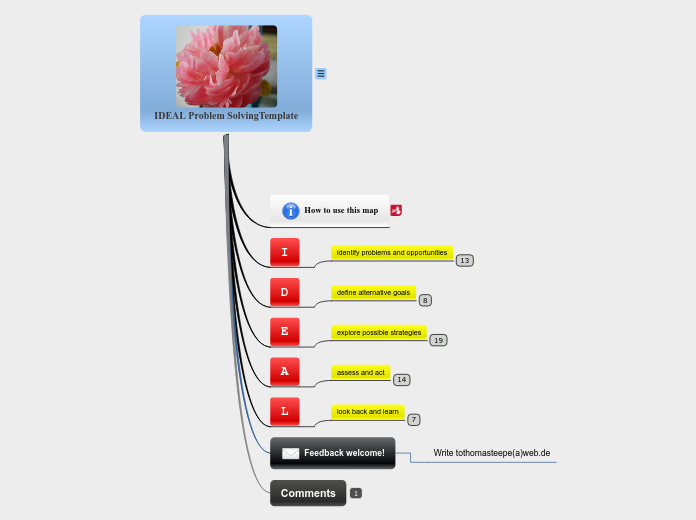av Thomas Teepe 5 år siden
21045
IDEAL Problem Solving Template
The IDEAL problem-solving strategy is a structured approach designed to aid individuals in tackling challenges effectively. It is derived from the work of John D. Bransford and Barry S.

av Thomas Teepe 5 år siden
21045

Mer som dette
Credits
The IDEAL problem solving strategy in this map is adapted from
"The IDEAL Problem Solver" by John D. Bransford and Barry S. Stein.
W. H. Freeman and Company, New York 1993.
Some of the other problem solving tools are taken from
"101 Creative Problem Solving Techniques" by James H. Higgins.
New Management Publishing Company, Winter Park 1994.
This is a sample comment.
improvements?
distance
sleep on it
talk to others
criticize
act
use "Getting Things Done" system
how-how?
assess
weighted ranking
pros and cons
ETHOS analysis
social
organisational
human
technical
economic
SCAMPER
reverse / rearrange
eliminate things
put things to other use
magnify / minimize things
adapt things
combine things
substitute something
morphological analysis
look for information
mail to experts
internet
literature
reversal - dereversal a.k.a. flip-flop
First ask:
"How could we make things even worse?" (This is usally fun.)
The ask what the opposites of these deteriorating measures are.
forced relationship
Take an area that is more or less unrelated to your problem. Take for example "music" when you are faced with a technical problem.
Then collect concepts from music - orchestra, instruments, score...
Transfer these concepts to your problem.
explore analogies
Look for areas where problems similar to yours have already been solved. Don't hesitate to borrow good ideas.
Example:
You want to construct an revolutionary new automatic toothbrush. One way to look at it is via the question "How can dirt be removed?" So start with brooms, rags, lawn mowers, water hoses and see where these ideas may lead you.
brainstorming
Main idea of brainstorming:
Separate the stages of idea collection and idea evaluation.
Do not criticize ideas in the collection phase.
double question
The question "how to make it OK n o t to solve the problem" directs the view to solutions outside your initial concept of your problem. (Some problems don't have to be solved.)
how can I make it OK not to solve the problem?
how can I solve the problem?
visualize outcome
Imagine the state of things when you have reached a certain goal. Imagine a "mental movie".
Make a drawing.
Napoleon technique
The somewhat grand name "Napoleon technique" means simply this:
Ask yourself what a person like Napoleon would do with your problem or in your situation or which goals he might set for himself.
Of course, you may want to replace Napoleon by any historical figure or fictional character that might deal with your problem in a useful way.
best thing to do?
analyse causes
fishbone diagram
why-why technique
The why-why technique is used to find out the causes of a problem.
Start with the initial problem. Ask "Why is this so?" and collect a number of causes. For each of these causes (or at least the most imporatnt ones) ask again "Why is this so?".
This way, you quickly get a good impression of the root causes of the problem.
draw a figure
collect questions
...
how?
why?
what?
describe the problem
take different points of view